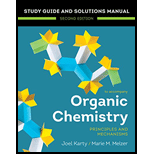
Concept explainers
Interpretation:
It is to be explained how the given synthesis, where
Concept introduction:
Synthesis may be designed by thinking in the reverse direction, from the product to the starting compound, in a method called retrosynthesis. Retrosynthesis involves starting with the product and determining a suitable precursor from which it can be synthesized, without considering specific reactions. The precursor must be a simpler molecule, which may or may not have a close structural relation to the target molecule. This process is repeated until an easily available (or easily prepared) precursor is reached. Each of these steps is called a transform. A synthesis is a specific sequence of
Want to see the full answer?
Check out a sample textbook solution
Chapter 13 Solutions
Organic Chemistry: Principles And Mechanisms: Study Guide/solutions Manual (second)
- An α carbon of a ketone or aldehyde can be alkylated or halogenated under basic conditions. Recall that multiple halogenations take place under these conditions, whereas polyalkylation is generally not a concern. Suggest whyarrow_forward10. In chapter 18, we learned that benzene (the most prevalent aromatic ring) reacts with good electrophiles in electrophilic aromatic substitution (EAS) reactions. In chapter 17, we learned there are many other aromatic rings other than benzene. These other aromatic rings can participate in EAS reactions much the same way. The following is an EAS reaction with pyrrole as the starting nucleophile. Draw the complete, detailed mechanism for the formation of the given major product. Include all resonance structures in the sigma complex. BC13arrow_forwardGive detailed Solution with explanation neededarrow_forward
- Please answer very soon will give rating surelyarrow_forward(SYN) Show how to synthesize 2,4-diphenylbut-2-ene using phenylethanoic acid (phenylacetic acid) as your only source of carbon atoms.arrow_forwardWhat is the slow (rate-determining) step in any electrophilic aromatic substitution reaction? Please provide a detailed explanation.arrow_forward
- Complete the mechanism of hydration of alkene below. Please follow curved arrows to predict the resulting structures in each step Step 1 of hydration of 2-methyl-1-propene (Note that the most stable carbocation is formed here) Step 2 of hydration of 2-methyl-1-propene(Note that the most stable carbocation is formed here) Step 3 of hydration of 2-methyl-1-propenearrow_forwardIn the following electrophilic aromatic substitution reactions, the overall transformation is the substitution of one aromatic hydrogen atom for a nitro group. The major products of these syntheses are different. Please explain the observation below using complete sentences. I already asked this question but the explanation was in their own hand writing and also unclear,can you type the reasoning please and show the steps?arrow_forwardFor the structures shown below, state the number of pi electrons present in the molecule. H H H H * H H H Number of pi electrons -6 ماتاد V H Number of pi electrons Is the molecule aromatic according to the Huckel criteria? N H If the molecule were planar, would it be antiaromatic?arrow_forward
- I. Of the following reactions, answer what is requested:a) Analyze the type of alkyl halide and determine if the nucleophile is strong or weak and also if it has a basic character.b) According to the previous paragraph, determine if there is competition between the substitution and elimination reactions.c) Describe the mechanism of each of the product (s) that are formedd) Of the product (s) that are formed, indicate which one comes from the substitution reaction and which one from eliminatione) If two or more products are formed, indicate which would be the majority and explain why.arrow_forward(please correct answer and don't use hend raiting) Propose a plausible mechanism for the followingarrow_forwardComplete the following multistep synthesisarrow_forward
 Organic Chemistry: A Guided InquiryChemistryISBN:9780618974122Author:Andrei StraumanisPublisher:Cengage Learning
Organic Chemistry: A Guided InquiryChemistryISBN:9780618974122Author:Andrei StraumanisPublisher:Cengage Learning
